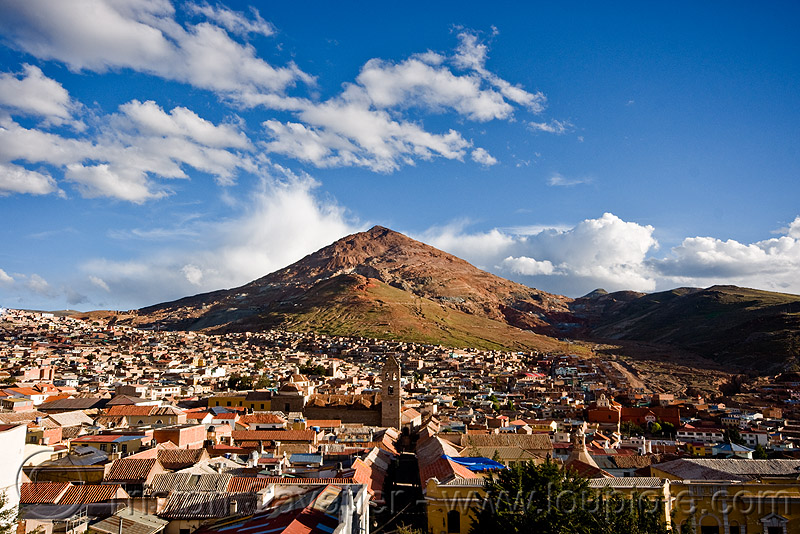In the year 1545, a man by the name Diego Huallpa accidentally discovered Potosi in Boliva, also known as Cerro Rico.1 Cerro Rico means rich mountains, which, in this case, it definitely was. When traveling between cities, Diego Huallpa was asked to climb a mountain; after getting to the top he slipped and fell and found on the side of the mountain some silver. Diego Huallpa immediately took his findings to his boss, which was a Spanish overseer at a nearby mine. Shortly after, that mountain was quickly inhabited by thousands of Spaniards and Indians. The silver of this mountain quickly drew the attention of the Spanish conquistadors. When these conquistadors arrived, they began to colonize the area surrounding the mountain.2 By 1672, the surrounding area reached its highest population of 200,000 people, and was one of the richest cities of its era.3 It became a very strong anchor for the Spanish Empire. This city sent Spain’s economy to new heights, making the Spanish more powerful than before.4
Silver during the sixteenth century was one of the most sought-after metals in all of Spain.5 The area itself surrounding the mountain was not a healthy environment, and the air was constantly filled with dust and debris. Miners were only expected to live to be around forty years old.6 To make matters worse, Potosi is the highest city in the world, making the air thin and hard to breathe. The city resides 4000 meters above sea level.7 All in all, the surrounding area was a cruel place to live, but the Spaniards stayed due to the wealth they achieved. This wealth was achieved easily for the Spanish, but came at a great price to the indigenous Indians and to the African slaves.8

Potosi was a cruel, horrible place for anyone who worked there. The process of mining in the sixteenth century was not an easy one. It was extremely laborious and hard for all miners. The Spanish conquered the Andeans and put them through rough, intensive work.9 Though the Indians were not slaves they were sometime treated as such. Some Spanish conquistadors would lend Indians under their care to other miners. At Potosi, as elsewhere in Spanish South America, the Spanish implemented the mita system of labor. In this system, miners would be given a certain number of days to work per week, and then they would relax on the other days. Though it was more intense, all ages would be put to work, ranging from eighteen to fifty years old.10 Before the Spanish empire found an easier way to mine, they used the classic way of mining, which was extremely laborious.11 The Indians were to use iron bars to chip out iron ores, which was then carried down the mountain, where it would be heated in order to extract the silver.12 The mountain was a very dangerous place, due to its close spaces with very little air.
The silver industry in the sixteenth century really flourished. It was in great demand and needed for the Spanish and Europeans.13 Even though mining slowed down after Bolivia received independence, Potosi, still to this day is a high producer of silver.14 The Potosi mountains have had several years where they have really good production, but that has also come with several bad years.15 Still to this day Potosi is a high producer of silver and tin, causing Potosi to be one of the oldest mining cities in the New World.16
- Oxford Research Encyclopedia, May 2015, s.v. “Potosí Mines,” by Kris Lane. ↵
- Oxford Research Encyclopedia, May 2015, s.v. “Potosí Mines,” by Kris Lane. ↵
- New World Encyclopedia, February 2017, s.v. “Potosí.” ↵
- Oxford Research Encyclopedia, May 2015, s.v. “Potosí Mines,” by Kris Lane. ↵
- History of World Trade Since 1450, 2006, s.v. “Potosí,” by Peter Bakewell. ↵
- New World Encyclopedia, February 2017, s.v. “Potosí.” ↵
- Oxford Research Encyclopedia, May 2015, s.v. “Potosí Mines,” by Kris Lane. ↵
- Tom Zoellner, “The Mountain That Eats Men,” World Literature Today (serial online) 88(3/4) (May 2014): 83-87. ↵
- Oxford Research Encyclopedia, May 2015, s.v. “Potosí Mines,” by Kris Lane. ↵
- Oxford Research Encyclopedia, May 2015, s.v. “Potosí Mines,” by Kris Lane. ↵
- Tom Zoellner, “The Mountain That Eats Men,” World Literature Today (serial online) 88(3/4) (May 2014): 83-87. ↵
- Oxford Research Encyclopedia, May 2015, s.v. “Potosí Mines,” by Kris Lane. ↵
- History of World Trade Since 1450, 2006, s.v. “Potosí,” by Peter Bakewell. ↵
- New World Encyclopedia, February 2017, s.v. “Potosí.” ↵
- Oxford Research Encyclopedia, May 2015, s.v. “Potosí Mines,” by Kris Lane. ↵
- Oxford Research Encyclopedia, May 2015, s.v. “Potosí Mines,” by Kris Lane. ↵



63 comments
Gabriela Medrano
I did not know Potosi was a city of mining, and that the discovery of it was accidental. You did a great job of painting the picture of what a hostile environment the people who came to settle in were living. It is interesting to see how wealth can drive some people mad, to the extent of cutting their life short by nearly half of their expected life span, and enslaving people to do all the laborious work. This was such an interesting topic, great article!
Elizabeth Garibay
Great written article! Before reading this I had never heard of Potosi before. I believe that although the living conditions and working were terrible, people continued mining because they had to for money and support. Sometimes people sacrifice for their love don’t ones . And when I read that the life expectancy was of forty , I almost fainted! Although they were working hard, they were in a way working hard to die ! But Great Job!!
Mario De Leon
Very interesting article! I find it interesting that Diego Huallpa came across the silver by accident when he slipped and fell. While the discovery of this silver rich mountain is great it is sad that the indigenous people are the ones who have to suffer at the hands of this discovery. It is also interesting that Potosi is still producing silver!
Nataly Solis Chavez
Hello Luke, thank you for providing us with such valuable information. This is an example of an awesome historical article that isn’t dreadful to read through. Instead your writing style is clear and concise getting your point across explicitly! I myself had never heard of Potosi before and it is unfortunate to learn of such maltreatment and exploitation but all in all your article is great!
Briana Bustamante
Very well written article! I’ve never heard of Potosi before. I personally find it crazy that although the working and living conditions were terrible, people continued mining. And a life expectancy of forty is just insane! It was like they were putting their life on the line to live at a higher cost. I feel that the title of your article really tied into what the main idea is about. Great Job!!
Elizabeth Garibay
Great article! I had never heard of Potosi before and it was interesting to learn about this city and to learn that it helped the Spanish Empire flourish. Although reading into it, it was horrible to learn about how the people were treated and about the living conditions the Natives and African labor that the Spaniards used to extract the silver from the mountain. Also crazy to have read that the life expectancy was 40? wow. Amazing article!
Hayden Hollinger
This was a great article on a very interesting topic. I had never heard of Potosi, but I have enjoyed learning more about Latin America, and this article certainly helped me do this. I like how Diego Huallpa accidentally came across this area, and it ended up making the Spanish more powerful than they had ever been up until this point. I like the fact there were many sources, which tell me this article was very well researched.
Alyssa Valdez
Very well written article! I learn something new every day. I did not know much about Potosi, so I thought your article was very compelling. I can tell you spent a lot of time and effort into your article! It so tragic how so many people had to live in such terrible living conditions, and I even find it more sad that greed and make people so ugly.
Jennifer Pogue
I have never before heard about the silver mining in south America. It hurts me to think about the horrible conditions the Natives and Africans were in. Not only was it hard and tedious work, the mountains themselves were dangerous. Greed always brings destruction. Your title is amazing and it is clear to see you put a lot of research in this article.
Cameron Mays
This article seemed well-researched and had a good, interesting, and not heavily discussed topic. However, given the things I just said, I wasn’t able to fully appreciate the article because your sentence structure and grammar through me off, as if it wasn’t proof-read completely. I noticed this heavily in the first paragraph where the way you were conveying things just doesn’t sound correct at all when verbally said.